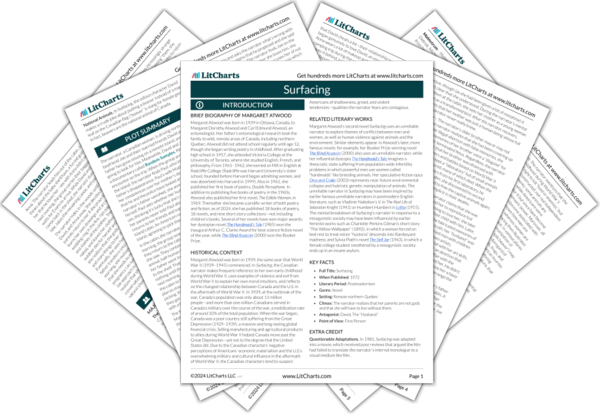Surfacing represents religion as a psychological phenomenon derived from family dynamics: essentially, it shows how children derive their ideas about God or gods from their parents, who appear all-powerful and undying to their children. If the children are brought up in a religious tradition like Christianity, the novel suggests that they can transfer their natural, childish beliefs about their parents’ power and immortality from their human parents to a divine figure like God. This transfer, the novel suggests, can make losing one’s parents easier, as children then have another parent figure—God—present in their lives after their parents’ passing. If children are not brought up in a religious tradition, on the other hand, the novel shows that they worship their parents until their parents fail or die—at which point they learn to recognize their parents’ humanity. This dynamic is clearest in the religious attitudes of the narrator, who grew up in an atheist household. Though she begged her parents to let her attend Sunday school because she was curious about religion and wanted to fit in with her more religious classmates, she quickly lost interest in God when she realized that God wouldn’t necessarily give her the things she prayed for. Yet as an adult going through a psychological and emotional crisis after her mother has died and her father has gone missing, the narrator processes her grief by briefly worshipping her parents as literal gods, feeling their presence, power, and guidance despite their physical absence. After she has finished grieving, she realizes her dead parents’ humanity for the first time. In this way, the novel represents religion and worship as a natural psychological phenomenon that adults can outgrow by recognizing their parents’ humanity.
Religion and Family ThemeTracker

Religion and Family Quotes in Surfacing
I recall the feeling, puzzled, baffled, when I found out some words were dirty and the rest were clean. The bad ones in French were the religious ones, the worst ones in any language were what they were most afraid of and in English it was the body, that was even scarier than God.
I had the proof now, indisputable, of sanity and therefore of death.
If you tell your children God doesn’t exist they will be forced to believe that you are the God, but what happens when they find out you are human after all, you have to grow old and die?
I willed it, I called to them, that they should arrive is logical; but logic is a wall, I built it, on the other side is terror.
No gods to help me now, they’re questionable once more, theoretical as Jesus. They’ve receded, back to the past, inside the skull, it is the same place.
















